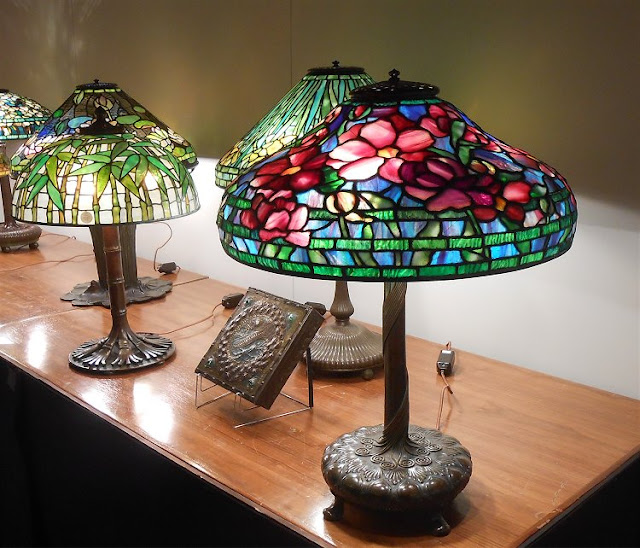The Palm Beach Show of Jewelry, Art, and Antiques was held last week.
It was splendid, as usual. They have artworks in every medium; glass is special.
There are two major dealers in Tiffany lamps, Macklowe and Lillian Nassau.
These range in price from $50,000 - $120,000.
Tiffany Pink Peony Lamp with bronze base. All Tiffany lamps have bronze bases,
and the glass is mottled, not flat. Each is a separate piece of glass, and they are held
together with lead strips or copper foil.
Close-up of lamp. You can easily see the mottled colors of the glass and the dark lines
of lead or copper. In 2007 it was discovered that Tiffany did not design these lamps.
The chief designer was Clara Driscoll, and there was a whole studio of women
designers who created all of the lamps. Tiffany was the salesman only.
"Water Lily Lamp."
More than 300 workers were employed in Tiffany's interior design company.
Male artisans took the designs of Clara and fabricated the shades, each one by hand.
There were hundreds of bins of different colored pieces of glass from which the
craftsmen would select pieces. Thus no two pieces are exactly the same.
Five Tiffany lamps in the Macklowe booth.
Pink Peony Hanging Shade.
Jade Green Lamp
Dragon Fly Lamp, which was very popular. Tiffany printed a catalog showing
the designs, and you could order from the catalog. You can see the wings were
created separately and attached to the surface. Copper foil held the smaller
pieces together, while lead strips held the larger.
Five Tiffany lamps in the Lillian Nassau booth.
Wisteria Lamp with bronze base is the most famous and designed by Clara Driscoll.
This piece was selling for $770,000. The record at auction for a Tiffany lamp
is $2.8 million.
Close-up of the Wisteria Lamp. Note here the variations in colors of the
individual pieces of glass. They are endlessly fascinating.
The style came to epitomize Art Nouveau in America.
Red Tulip Lamp with unique base.
Multiple Lily Lamp with favrile glass. This was sold in many sizes with different
bases. There is a larger example with more lamps in the Driestadt Museum in Chicago.
Peony Garden Shade on Standing Lamp.
Venetian Table Lamp with very delicate base.
Pink Peonies Standing Lamp
Close-up showing the mottled colors in each piece. These are what makes true Tiffany
lamps so beautiful and fascinating.
But there were other types of Art Nouveau glass in the early 20th century.
In Nancy, France, Daum began to create pieces using the ancient Egyptian technique
of pate-de-verre, in which ground up glass is put into a refractory mold and then
heated until it fused. The Daum company is the only company in the world still
today using the technique.
Emile Galle, in France, created cameo glass. Here, several gathers of glass
are used to create a multi-layered piece, which is then cut and ground to bring out
an image from the various layers. The same technique as cameos in stone.
A French cameo glass vase, but not Galle.
Glass in 2020 is still a precious art form. The Berengo Studio in Murano, Venice, Italy,
works with artists in other mediums to create unique artworks.. Here the Spanish artist,
Juan Ripolles. creates the deigns which are then formed in glass by the expert glassblowers
on the Island of Murano in Italy.
Thomas Hawkes. "Crystal Persian Salad Bowl." American
Mr. Hawkes started a business to create fine crystal.
Rene Lalique. "Paradox." Cast Glass. France.
Art glass is produced in many ways: blown, cast, slumped, fused, cut, etc.
Lalique created beautiful forms by pouring the glass in molds, which could then be
re-used to create multiple forms. He believed every, regardless of wealth, should
be able to enjoy fine art in their home.
René Lalique. "Swan Centerpiece." France.
René Lalique. "Pair of Swans Cen terpiece." Cast Glass. France.
Massimo Lunardon. "Alien." Murano Blown Glass.
Lunardon is an Italian artist who works with the glass artists on Murano to create his
playful "Alens" in silver and bright colors. He also designs function glassware for
upscale department stores around the world.
Massimo Lunardon. "Alien Meditating." Murano Blown Glass.
__
A Colombian emerald and diamond necklace.
Jewelry plays a very large role at the Palm Beach Show; the ladies of Palm Beach arrive
each day with their checkbooks ready. Most select a new piece each year - a new stone,
a new color, a new form. They are of the finest quality and displayed in profusion,
more than I see anywhere else. The jewelers generally are friendly and helpful.
They tell me about the stones and how they are worked, and they allow me to try on
a few spectacular pieces. There are thousands of rings and brooches, but I prefer the
full flowering of the necklaces.
A Burmese ruby and diamond necklace.
A diamond choker necklace.
A necklace of blue sapphires and diamonds.
I tried on a $5.6 million sapphire ring. Very nice.
A necklace of pink sapphires and diamonds.
I enjoy the colored stones particularly, and there are many of them. The three best
dealers, in my opinion, were Takat, Bayco, and Yafa. Bayco is a family business,
and I met three generations: young lady salesperson, her uncle, and grandpa, all
very nice.
More to come in other media.
__

































Spectacular jewelry! So outstanding that I wonder if it's like an dress design and a woman can only wear it once! Everyone will remember she wore it last year.
ReplyDeleteThe glass was wonderful Your photos are terrific.